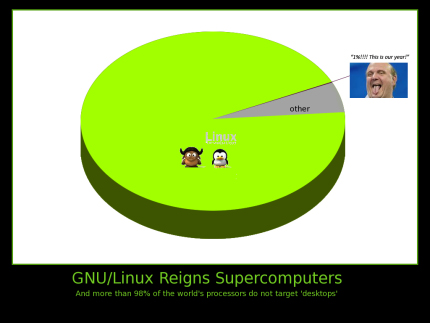Also: Gartner "Lie Alart"
ONCE EVERY MONTH or so we are seeing the fraudulent suggestion that 'market share' (installed base) of GNU/Linux on the desktop is less than 1%. Even Microsoft knows that this is false.
Where is it all coming from? Some self-appointed statistics 'company' called Net Applications, which keeps its dataset secret, admits that it does not count actual traffic, and does not say who/what funds the bulk of its work.
The following post, which we
remarked on before, covers some of these point (more
here,
here,
here and
here).
For those who are easily deceived by these arbitrary numbers, here is a
must-read reference. People have blind faith in pies and other charts, provided they are cited and repeated often enough. It helps them spread. It's the masterful art of turning big lies into consensus.
Net Applications admits to skewed statistics
In an article at "The Industry Standard", Net Applications apparently admit that their numbers are skewed. More specifically, they admit that they are skewed towards certain regions of the world (US-centric, anyone?). In such an amazing moment of honesty, I wonder why they didn't also admit to actively editing their own statistics.
One of the bigger pushers -- or essentially promoters -- of these 'Fisher Price' statistics has been IDG (of IDC). Let us not forget that IDC|IDG is essentially funded by Microsoft [
1,
2] and its
attacks Microsoft's competitors are telling. For some more background, c/f "Analysts Cartel" [
1,
2,
3,
4,
5]. In this series of posts we also saw DaniWeb falling for IDG's attacks against GNU/Linux in the enterprise (2 weeks ago). In fact, even at this very moment, IDG comes out again out again with an message against migration to GNU/Linux:
"Unix-to-Linux migration not always needed: users"
There is another goodie in the news.
Forrester has already conducted anti-Linux studies (sponsored by Microsoft of course) and now it's suggesting that, at least in the enterprise,
Windows Vista adoption remains below 10%. A similar analysis from a year ago suggested that Vista adoption in enterprises was 1%. This was gauged after well over a year of Vista availability and pressure through OEMs to abolish XP.
Just over two years since Microsoft launched Windows Vista, less than 10 per cent of PCs in the enterprise are running the successor to the company's eight-year-old Windows XP.
In
this news article, Gartner also crowns IBM, Microsoft and Oracle. What Gartner does not disclose is the fact that
among its biggest private investors there are Bill Gates and Larry Ellison. What if Gartner did not treat these people and their companies well? Would Gartner be able to survive without those investments? IBM happens to be a regular large customer as well.
⬆

Edited in response to a similar figure with
inversed figures from Digg (click to enlarge)

